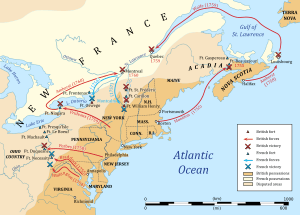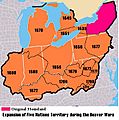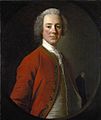French and Indian War facts for kids
Quick facts for kids French and Indian War |
|||||||||
|---|---|---|---|---|---|---|---|---|---|
| Part of the Seven Years' War | |||||||||
 The war theater |
|||||||||
|
|||||||||
| Belligerents | |||||||||
|
|||||||||
| Commanders and leaders | |||||||||
|
|||||||||
| Strength | |||||||||
| 42,000 regulars and militia (peak strength, 1758) | 10,000 regulars (troupes de la terre and troupes de la marine, peak strength, 1757) | ||||||||
| Casualties and losses | |||||||||
|
Unknown | ||||||||
The French and Indian War was fought between 1754 and 1763 in British North America and French North America. They fought over land which is now in the United States and Canada. The French had some Native American allies and the British had other allies.
The conflict took place during the Seven Years' War. France was already fighting Prussia. Because of this, they did not send many troops to Canada.
Contents
Causes
- Both the British and the French thought that they owned the Ohio Country. The Ohio Country is land between the Appalachian Mountains and the Mississippi River, from the Great Lakes to the Ohio River. France wanted to keep New France, and Britain wanted to prevent that. Both countries wanted to control this land that produced beaver pelt for fur trade and expected to send settlers someday.
- Both European countries used Native American claims to the land. The British said that it belonged to the Iroquois, and the French said it belonged to their Huron tribe. Neither side asked what the people of the Ohio Country might want.
- The British Thirteen Colonies feared control of the Pope in North America. France was controlled by the Roman Catholic Church. The British settlers were Protestant and saw that as a threat to their religious freedoms, which they had under English law.
Battles
The French built a new fort in the territory they both wanted, and the British decided to try to get them to leave. After failing in a small battle in 1754 they tried again with the Battle of Monongahela in 1755. The British commander, General Edward Braddock, led 1,500 British soldiers in an attack on Fort Duquesne. He failed and died with many of his men. A militia officer, George Washington, led the defeated survivors home.
In 1756, the French captured the British Fort Oswego. They took more than 1,700 British soldiers captive.
The French were victorious again at Fort William Henry in 1757. After they captured the fort, the Indians did not follow the rules of British surrender. They killed about 150 British soldiers after they had surrendered.
In 1759, at the Battle of the Plains of Abraham (also called the Battle of Quebec), the British defeated the French and took control of Quebec City.
In 1760, Field Marshal Jeffery Amherst led the British in the defeat of the French. The British took control of Montreal.
Outcome
The fighting in North America stopped on September 8, 1760, with the French surrender of Montreal and the rest of Canada to the British.
The war ended with the signing of the Treaty of Paris on February 10, 1763. France had to give its North American lands east of the Mississippi River to Britain except the small islands of Saint Pierre and Miquelon, near Newfoundland. Britain offered France the choice to give up its Canadian land or the Caribbean islands of Guadeloupe and Martinique, which British troops had taken during the war. France chose to keep the islands, which were valuable for their sugar plantations.
With the Royal Proclamation of 1763, colonists in British North America became unhappy over their share of the winnings. The war had been expensive and England began taxing the American colonists to pay for it. These were two of the causes of the American Revolution.
Interesting facts about the French and Indian War
- Some Indian tribes helped the French fight because the French had been better at befriending them than the British had.
- To encourage the colonies to unite in the battle against the French and Indians, Benjamin Franklin printed a drawing showing the colonies as parts of a chopped-up, writhing snake. It was the first political cartoon printed in America.
- Roland-Michel Barrin de la Galissonière, the governor of New France, had signs made of lead that told settlers and travelers that they were traveling on French land.
- While most Indian tribes sided with the French, there were a few that sided with the English.
- Many present-day Cajuns are descendants of these French and Indian War refugees that settled in Louisiana.
- The war inspired the song “Yankee Doodle.”
- Spain, which allied with France in 1762, was forced to give Florida to the British.
- George Washington was a colonel in the British militia during the war.
Images for kids
-
Participants in the Seven Years' War. Canadians and Europeans view the French and Indian War as part of the Seven Years' War, while Americans view it as a separate conflict.
-
The coureurs des bois were French Canadian fur traders, who did business with natives throughout the Mississippi and St. Lawrence watershed.
-
Map of Iroquois expansion, 1711. By the mid-18th century, the Iroquois Confederacy had expanded from Upstate New York to the Ohio Country.
-
Roland-Michel Barrin de La Galissonière, the Governor of New France sent an expedition in 1749 into the Ohio Country in an attempt to declare French sovereignty.
-
Fort Le Boeuf in 1754. In the spring of 1753, the French began to build a series of forts in the Ohio Country.
-
Washington with his war council during the Battle of Fort Necessity.
-
In June 1755, the British captured French naval ships sent to provide war matériel to the Acadian and Mi'kmaw militias in Nova Scotia.
-
British forces under fire from the French and Indian forces at Monongahela, when the Braddock expedition failed to take Fort Duquesne.
-
British raid on the Acadian settlement of Grimross. Efforts to undermine the French Fortress of Louisbourg resulted in the the Acadians being forced to leave.
-
In January 1756, John Campbell was named as the new British Commander-in-Chief, North America.
-
In August 1756, French soldiers and native warriors led by Louis-Joseph de Montcalm successfully attacked Fort Oswego.
-
A British expedition sent to invade Canada was repelled by the French at the Battle of Carillon in July 1758.
-
After a three-month siege of Quebec City, British forces captured the city at the Plains of Abraham.
-
French authorities surrendering Montreal to British forces in 1760.
-
The resulting peace dramatically changed the political landscape of North America, with New France ceded to the British and the Spanish.
-
The Quebec Act passed in 1774. It addressed several complaints held by French Canadians and Indians, although it angered American colonists.
See also
 In Spanish: Guerra franco-indígena para niños
In Spanish: Guerra franco-indígena para niños


















